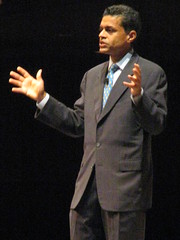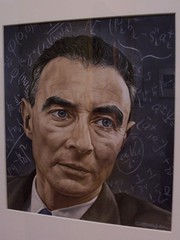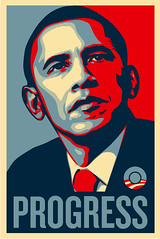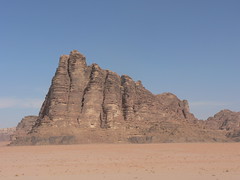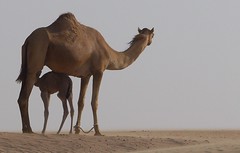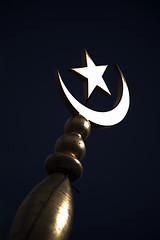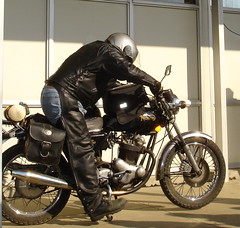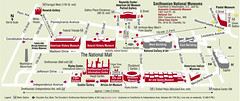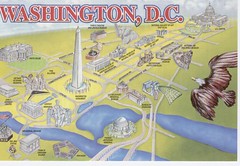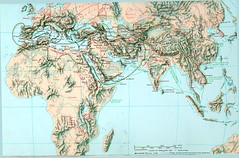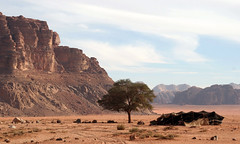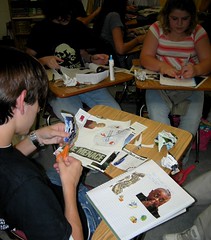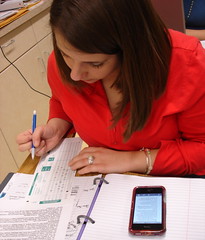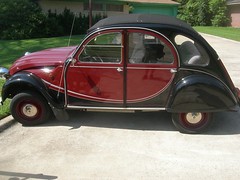Abraham the Patriarch / Ibrahim the Prophet
Abraham (Ibrāhīm) is a figure in the Torah, Bible, and Quran whom Jewish, Christian and Muslim believers regard as the founding patriarch of the Israelites, Arabs and Edomite peoples, says Wikipedia.org.
According to the Torah, Abraham was brought by God from Mesopotamia to the land of Canaan, around 2000 BCE[1] There entered into a covenant: in exchange for sole recognition of Yahweh as supreme universal deity and authority, Abraham will be blessed with innumerable progeny.
His original name was Abram, meaning either "exalted father". For the latter part of his life, he was called Abraham, "father of many (nations)" per Genesis 17:5, although it does not have any literal meaning in Hebrew.[1]
Judaism, Christianity and Islam are sometimes referred to as the "Abrahamic religions", because of the role Abraham plays in their holy books.
In the Jewish tradition, he is called Avraham Avinu or "Abraham, our Father". God promised Abraham that through his offspring, all the nations of the world will come to be blessed (Genesis 12:3), interpreted in Christian tradition as a reference to Christ.
Jews, Christians, and Muslims consider him father of the people of Israel through his son Isaac (cf. Exodus 6:3, Exodus 32:13).
For Muslims, he is a prophet of Islam and the ancestor of Muhammad through his other son Ishmael.
Friday, January 30, 2009
Wednesday, January 28, 2009
Who brings understanding of Asian world to the US? Author Fareed Zakaria
As the world searches for someone who fills the role established by TE Lawrence, that of a bridge-builder between the Western and Asian worlds, one who comes to mind ia writer Fareed Zakaria (born January 20, 1964). He is an Indian-born naturalized American journalist, author, and television host specializing in international relations, says Wikipedia.
Zakaria has appeared in virtually every medium and within multiple news agencies, with Forbes calling him "ubiquitous" as well as "omniscient" in the American media.[1]
Zakaria is regarded variously as a political liberal,[1][5] a neoconservative,[6], a conservative,[7] or a moderate.[8] He supported President Ronald Reagan in the past, but currently self-identifies as a "centrist".[6]
Zakaria is the author of From Wealth to Power: The Unusual Origins of America's World Role (Princeton, 1998), The Future of Freedom (Norton, 2003), and The Post-American World (2008).
Zakaria has appeared in virtually every medium and within multiple news agencies, with Forbes calling him "ubiquitous" as well as "omniscient" in the American media.[1]
Zakaria is regarded variously as a political liberal,[1][5] a neoconservative,[6], a conservative,[7] or a moderate.[8] He supported President Ronald Reagan in the past, but currently self-identifies as a "centrist".[6]
Zakaria is the author of From Wealth to Power: The Unusual Origins of America's World Role (Princeton, 1998), The Future of Freedom (Norton, 2003), and The Post-American World (2008).
J. Robert Oppenheimer (1904-1967): called father of the atomic bomb
J. Robert Oppenheimer[1][2][3] (April 22, 1904 – February 18, 1967) was an American theoretical physicist and professor of physics at the University of California, Berkeley, notes Wikipedia.
He is best known for his role as the scientific director of the Manhattan Project: the World War II effort to develop the first nuclear weapons at the secret Los Alamos National Laboratory in New Mexico. For this reason he is remembered as "the father of the atomic bomb". In reference to the Trinity test in New Mexico, where his Los Alamos team first tested the bomb,
Oppenheimer famously recalled the Bhagavad Gita: "If the radiance of a thousand suns were to burst at once into the sky, that would be like the splendor of the mighty one." and "Now I am become Death, the destroyer of worlds."
After the war Oppenheimer was a chief advisor to the newly created United States Atomic Energy Commission and used that position to lobby for international control of atomic energy and to avert the nuclear arms race with the Soviet Union.
He is best known for his role as the scientific director of the Manhattan Project: the World War II effort to develop the first nuclear weapons at the secret Los Alamos National Laboratory in New Mexico. For this reason he is remembered as "the father of the atomic bomb". In reference to the Trinity test in New Mexico, where his Los Alamos team first tested the bomb,
Oppenheimer famously recalled the Bhagavad Gita: "If the radiance of a thousand suns were to burst at once into the sky, that would be like the splendor of the mighty one." and "Now I am become Death, the destroyer of worlds."
After the war Oppenheimer was a chief advisor to the newly created United States Atomic Energy Commission and used that position to lobby for international control of atomic energy and to avert the nuclear arms race with the Soviet Union.
Tuesday, January 27, 2009
Obama quiz
The quiz on Barack Hussein Obama / Trudeau
1. Barack Obama's father was a native of the nation of a) Tanzania b) Kansas
c) Kuwait d) Kenya.
2. Obama did his undergraduate work at Columbia University, which is in a) NYC
b) Boston c) Honolulu d) Philadelphia.
3. Both he and Michelle graduated from Harvard Law, which is in a) NYC
b) Boston c) Honolulu d) Philadelphia.
4. In addition to politics, he has been a teacher of consitutional law at the Univ of a) Illinois b) Chicago c) Indiana d) Washington.
5. He spent 14 years of his childhood in Indonesia. T / F
6. Obama used alcohol, marijuana, and cocaine during his years as a community organizer. T / F
7. Obama has been both a US Representative and US Senator from greater Chicago. T / F
8. He is the successful author of a book called a) Dreams from My Father
b) A Tale of Two Cities c) Invisible man d) Gone with the Wind.
9. The name Hussein indicates a Muslim influence in his family; it comes from a) Kenya b) Indonesia c) Hawaii.
From Wikipedia:
With his black Kenyan father and white American mother, his upbringing in Honolulu and Jakarta, and his Ivy League education, Obama's early life experiences differ markedly from those of African-American politicians who launched their careers in the 1960s through participation in the civil rights movement.[204] Expressing puzzlement over questions about whether he is "black enough", Obama told an August 2007 meeting of the National Association of Black Journalists that the debate is not about his physical appearance or his record on issues of concern to black voters. Obama said that "we're still locked in this notion that if you appeal to white folks then there must be something wrong."
Based on the paragraph above:
10. Obama’s background represents the history and the struggle of the civil rights
movement in America. T / F
11. Obama’s appeal to voters of all ethnic groups has been a source of puzzlement to many Americans. T / F
1. Barack Obama's father was a native of the nation of a) Tanzania b) Kansas
c) Kuwait d) Kenya.
2. Obama did his undergraduate work at Columbia University, which is in a) NYC
b) Boston c) Honolulu d) Philadelphia.
3. Both he and Michelle graduated from Harvard Law, which is in a) NYC
b) Boston c) Honolulu d) Philadelphia.
4. In addition to politics, he has been a teacher of consitutional law at the Univ of a) Illinois b) Chicago c) Indiana d) Washington.
5. He spent 14 years of his childhood in Indonesia. T / F
6. Obama used alcohol, marijuana, and cocaine during his years as a community organizer. T / F
7. Obama has been both a US Representative and US Senator from greater Chicago. T / F
8. He is the successful author of a book called a) Dreams from My Father
b) A Tale of Two Cities c) Invisible man d) Gone with the Wind.
9. The name Hussein indicates a Muslim influence in his family; it comes from a) Kenya b) Indonesia c) Hawaii.
From Wikipedia:
With his black Kenyan father and white American mother, his upbringing in Honolulu and Jakarta, and his Ivy League education, Obama's early life experiences differ markedly from those of African-American politicians who launched their careers in the 1960s through participation in the civil rights movement.[204] Expressing puzzlement over questions about whether he is "black enough", Obama told an August 2007 meeting of the National Association of Black Journalists that the debate is not about his physical appearance or his record on issues of concern to black voters. Obama said that "we're still locked in this notion that if you appeal to white folks then there must be something wrong."
Based on the paragraph above:
10. Obama’s background represents the history and the struggle of the civil rights
movement in America. T / F
11. Obama’s appeal to voters of all ethnic groups has been a source of puzzlement to many Americans. T / F
Lawrence and Islam
World War I, 1914 - 1918, is when Lawrence won his fame.
WWI marked the opening of the modern era (examples):
* chemical warfare ("mustard gas")
* modern machine gun
* airplanes
* armored tanks
WWI
* England & France & allies Vs. Germany (whose allies included Turkey)
* In the Mid East, England controlled Egypt and Turkey was Germany's ally. The Turks controlled Arabia and most of the Mid East.
WWI
* The US entered the war in 1917. The isolationist spirit of America kept us out of the war for 3 years.
Teacher's thesis:
That the events of WWI as described in Lawrence of Arabia were part of the misunderstandings and frustrations that led to the founding of Arab-based, Muslim extremist groups such as al qaeda and led to the destruction of the WTC on 9-11, 2001.
The basics of Islam
Holy Mosque Mecca at night
Originally uploaded by chrisuk.
Islam: "submission to the will of God."
Muslim: "one who submits to the will of God."
* Spelling variation in Arabic vocabulary (Muslim, Moslem, etc): because it is difficult to translate Arabic vowels, the western world is undecided about which vowels to insert.
* fastest growing religion
* 1 billion adherents (global pop. 5 to 6 billion)
* 2nd largest religion, after Christianity.
* ex: US Army accomodates US soldiers who are Muslim; that group may be as large as 10,000 soldiers, according to The Nation.
While many Muslims in Persian Gulf nations and SE Asia are poor and poorly educated, American Muslims are often people of high educational achievement.
Timeline:
Abraham, 2000 BC Father of the Jews. Also Father of the Muslims.
Jesus of Nazareth: 1 AD
Muhammad: 600 AD, prophet of Islam.
Jerusalem, a city of 3 holy days each week. Friday the Muslims go to mosque for prayers. Saturday the Jews have shabbat (rest). Sunday, of course, is the Christian sabbath.
Monday, January 26, 2009
Lawrence of Arabia: 85-question study guide
Trudeau’s Study Guide to Lawrence of Arabia
A Basis for Testing, Discussion and Essays on the biographical movie.
Please answer questions as brief notes and use as a framework for each viewing.
This true story is based on books TE Lawrence wrote after the Arab campaigns. He won acclaim for his chronicle of war and politics, the Seven Pillars of Wisdom.
1) Movie director David Lean insists that the musical themes be heard by the audience over a black screen. He felt the composer’s score was classic.
2) The movie opens in England, 1935. Enjoy the brief but loving camera attention to a fine British motorcycle. L wrecks and is mortally injured.
Discuss motorcycles (Triumph, BSA, etc) as a symbol of British success in the Industrial Revolution.
3) The Lawrence funeral service is in St. Paul’s Cathedral, London, a burial place reserved for national heroes. Remarks heard in the crowd: L. was a complex fellow and not a perfect hero.
4) Cairo, Cartography department, British Army, about 1914. In several ways L. stands out from the soldiers with which he is serving. Explain. What is cartography?
L. is well-educated, speaks French and Arabic. Cartography: mapmaking.
5) What are the dates of WWI? Name the nations aligned with the British. Name the countries working with the Germans.
1914 - 1918; US enters war in 1917. Brits and French vs. Germans and Austria.
6) Vocab: overweening, dossier, Oxfordshire.
7) What language has L. studied in addition to his mother tongue and French? Arabic.
8) In Arabia there is a conflict between the nomadic, tribal Bedouin peoples and the Turks, rulers of the Turkish Ottoman Empire - which includes Arabia. Who’s on the German side?
9) Is “the Officer’s Mess” a term for a carelessly kept room or the principal lounge area?
10) Arabian tribes are led by the wise, if weary, Prince Feisal of Mecca (see Faisal today).
11) What is the attitude of L’s desert guide toward the British officer’s pistol carried by L.? How does L. use the pistol in making his way amongst the Bedouins?
12) The Arabic word for canyon, usually a dry, rocky area between mesas, is “wadi.” The wadi is where Arabs have typically made their settlements.
What do the existence of these stone canyons say about the ancient geography of this region?
13) The Harish versus the Hazimi: is murderous tribal warfare a historic part of life in the vast desert? Are there such conflicts today?
14) What kind of vessel is used to bring up water from the deep well in the desert? Goat skin.
15) Translate "Peace be with you” into Arabic.
16) L. sings a WWI era ditty called “The Man who Broke the Bank at Monte Carlo.” Where is Monte Carlo? In gambling, what does it mean to “break the bank”?
17) A Britishism for being posted to a unit is “seconded.”
18) What is meant by the term biplane?
19) Where did the Turks get airplanes? Not “at the store.”
20) What sound can Arabs seem not to be able to pronounce?
21) In the caravan some camels are surmounted by small, square tent enclosures. Who is in such a tent?
22) “Recite, then, as much of the __ as may be easy for you ... and seek ye the forgiveness of God. Verily, God is forgiving, merciful ...” These are the opening words of the Holy Qu’ran. The scene in Feisel’s tent is unusually respectful of Muslims. Why do I say “unusually”?
23) Lawrence quotes the Quran. How would he know such material?
24) In 1915 the top British priority in the Mid East was protection of a waterway important to their shipping and movement of warships. What is the name of this key passage, which connects the Mediterranean to the Indian Ocean?
25) In explaining to Feisel the reason for Britain’s worldwide power the British officer puts an emphasis on ... a) technology b) discipline c) skill d) wealth.
26) In the early 1900’s the city at the center of Islamic art, business and scholarship was not Mecca, nor Cairo. It was the capital of Syria:
a) Medina b) Damascus c) Jerusalem .
27) According to Feisel, do Arabs love the desert? If not, what do they love?
28) Feisel refers to the Islamic golden age. About what century did it occur? According to brainyencyclopedia.com, it lasted from about 750 to 1050 AD.
29) At the desert’s edge Lawrence spends a night concentrating on the Arab dilemma in their feckless fight against the Turks. He has a breakthrough. What is his solution?
30) A terrible desert’s difficulties must be surmounted by the Bedouin.
The desert is the a. Sahara b. Rub al kali c. Arezy an Nefud.
31) “The Howeitat are brigands.” Write a synonym for brigand.
32) What 3 nations has Lawrence visited thus far?
33) Can a man claiming to perform a miracle be judged guilty of blasphemy? Why or why not? By definition, miracles are created by __.
34) The boys who become Lawrence’s servants are unsuitable, he is told, because they are “outcast and parentless.” What would we call them?
35) What is a shilling?
36) “Allah favors the compassionate.” Offer a synonym for compassionate.
37) During the desert crossing Lawrence makes a point of use precious water for shaving. Why does he insist on shaving?
38) Which character has 2 African bodyguards? Is that a realistic note or an exaggeration?
39) In sh’Allah is a frequent interjection and means: a. If God is willing. b. God be with you. c. I believe in God. d. God is merciful.
40) Gasim the Bedouin falls off his camel and is lost in the desert during the night.
Why does Lawrence stubbornly insist on going back to try to find him?
41) In the desert the Bedouins find a place surrounded by trees where their camels can drink. It is called an __ . What kind of trees are those? __ __ .
42) An argument about the role of fate is waged between Lawrence and the Arabs.
The Englishman’s key phrase is “Nothing is __.”
43) Lawrence’s father, he explains, is Sir Thomas Chapman. What is the parent-based problem?
44) Lawrence is awarded the robes of a tribesman for his valorous service. Describe him as he faces the wearing of foreign clothing.
45) After some tricky negotiations Auda Abu Talib of the Howeitat says “Dine with me in __ Ruum!”
46) The camel driver’s stick is often used for another purpose. Describe.
47) Auda Abu Talib says “’The Arabs,’ What tribe is that?” What does he imply?
48) What is a guinea?
49) What city will be attacked by the combined tribes in a surprise raid? It lies on what body of water?
50) When the troops leave the wadi, the women watching them emit a high-pitched scream as encouragement. What is that called? a. ovulation b. ululation c. trepidation d. insubordination.
51) “The law says the man must die.” This is based on a code associated with a historic leader of Mesopotamia. a) Cyrus b) Hammurabi c) Darius.
52) In the tribal dispute - which almost begins a blood feud - who is the condemned murderer? Who is the executioner? What irony is there?
53) The Turks at Aqaba outnumber and outgun the Arabs but the Bedouin raiders are successful. What is their great advantage?
54) Lawrence declares he will cross the badlands of the Sinai Peninsula. Where is he going?
55) The servant boy Daud dies in the desert in a most unexpected way. What is it?
56) When a camel lies down, which set of legs folds first?
57) The spooky, abandoned buildings encountered on the edge of the Sinai actually lie beside the __ __ .
58) “Bringing a ‘wog’ into the Officer’s Mess” is offensive to many soldiers. Explain.
59) “Undisciplined, unpunctual, untidy; knowledge of languages, music, literature, etc.” Who is being described?
60) In WWI the British attacked the Turkish-held Mid East and drove the Turks from the holy city of __.
61) “You acted without orders.”
“Shouldn’t an officer use their initiative at all times?” Explain.
62) Lawrence leads Bedouin riders in swift attacks on the Turks that depend on surprise for success. Today that’s called __ warfare (French word).
63) The Bedouins are wary of being partners with the British. They believe that the British are thinking, “Let the Arabs drive out the Turks, then we’ll take over.”
T / F
64) Intermission is another opportunity for the director to air his score over a dark screen. What does this imply?
65) The American reporter called Bentley in the movie is another true element in the Lawrence story. The journalist’s real name is Lowell Thomas. What happens as a result of Bentley’s stories and photos?
66) Lawrence uses his expertise in explosives against the Turkish __.
67) What is the Geneva Code? a) guidelines for humane treatment of prisoners during war. b) a secret system used by the people of Switzerland.
68) What happens to the Bedouin army after the looting of Turkish trains?
69) Why does Lawrence shoot and kill his servant and friend Farraj?
70) Lawrence allows himself to be captured by the Turks in Deraa. Why?
71) Is there such a thing as a fair-haired, blue-eyed person of Middle Eastern blood?
Is a Circassian the same as a Caucasian?
72) Write a brief description of the location of the Caucasian Mountains.
73) On the eve of the battle for Jerusalem Lawrence has a breakdown. What action does he take?
74) The Sykes-Picot Treaty is an agreement at the end of WWI that proclaims that 2 nations will divide the control of the Middle East. Which European nations took over the defeated Turkish Empire?
75) Is Lawrence guilty of having told the Bedouins “half lies” about their future and control of their ancient lands? Was he guilty of naiveté?
76) What happened to Lawrence while being held by the Turks in Deraa?
77) On the eve of the attack on the Turks in Damascus, people notice that Lawrence is a changed man. Describe his attitude.
78) Lawrence’s personal troops are hired soldiers. The word for commercial soldiers is __.
79) General Allenby is chauffeured in what brand of British auto?
80) Who wins the race to conquer the Turks in Damascus? a) the Arabs b) the British.
81) The tribal people form a government in Damascus. It is called the __ National Council.
82) The Arab armies prove incapable of governing Damascus. What governance factors flummox the Arabs?
83) The Arab tribal leaders leave Damascus and return to their homes in __.
84) What factor in British life is repulsive to Lawrence in his return to Britain?
85) Lawrence did not want to be famous as a successful soldier. His desire was to be recognized as a significant writer. Did he reach his goal?
86) At what age does Lawrence die?
A Basis for Testing, Discussion and Essays on the biographical movie.
Please answer questions as brief notes and use as a framework for each viewing.
This true story is based on books TE Lawrence wrote after the Arab campaigns. He won acclaim for his chronicle of war and politics, the Seven Pillars of Wisdom.
1) Movie director David Lean insists that the musical themes be heard by the audience over a black screen. He felt the composer’s score was classic.
2) The movie opens in England, 1935. Enjoy the brief but loving camera attention to a fine British motorcycle. L wrecks and is mortally injured.
Discuss motorcycles (Triumph, BSA, etc) as a symbol of British success in the Industrial Revolution.
3) The Lawrence funeral service is in St. Paul’s Cathedral, London, a burial place reserved for national heroes. Remarks heard in the crowd: L. was a complex fellow and not a perfect hero.
4) Cairo, Cartography department, British Army, about 1914. In several ways L. stands out from the soldiers with which he is serving. Explain. What is cartography?
L. is well-educated, speaks French and Arabic. Cartography: mapmaking.
5) What are the dates of WWI? Name the nations aligned with the British. Name the countries working with the Germans.
1914 - 1918; US enters war in 1917. Brits and French vs. Germans and Austria.
6) Vocab: overweening, dossier, Oxfordshire.
7) What language has L. studied in addition to his mother tongue and French? Arabic.
8) In Arabia there is a conflict between the nomadic, tribal Bedouin peoples and the Turks, rulers of the Turkish Ottoman Empire - which includes Arabia. Who’s on the German side?
9) Is “the Officer’s Mess” a term for a carelessly kept room or the principal lounge area?
10) Arabian tribes are led by the wise, if weary, Prince Feisal of Mecca (see Faisal today).
11) What is the attitude of L’s desert guide toward the British officer’s pistol carried by L.? How does L. use the pistol in making his way amongst the Bedouins?
12) The Arabic word for canyon, usually a dry, rocky area between mesas, is “wadi.” The wadi is where Arabs have typically made their settlements.
What do the existence of these stone canyons say about the ancient geography of this region?
13) The Harish versus the Hazimi: is murderous tribal warfare a historic part of life in the vast desert? Are there such conflicts today?
14) What kind of vessel is used to bring up water from the deep well in the desert? Goat skin.
15) Translate "Peace be with you” into Arabic.
16) L. sings a WWI era ditty called “The Man who Broke the Bank at Monte Carlo.” Where is Monte Carlo? In gambling, what does it mean to “break the bank”?
17) A Britishism for being posted to a unit is “seconded.”
18) What is meant by the term biplane?
19) Where did the Turks get airplanes? Not “at the store.”
20) What sound can Arabs seem not to be able to pronounce?
21) In the caravan some camels are surmounted by small, square tent enclosures. Who is in such a tent?
22) “Recite, then, as much of the __ as may be easy for you ... and seek ye the forgiveness of God. Verily, God is forgiving, merciful ...” These are the opening words of the Holy Qu’ran. The scene in Feisel’s tent is unusually respectful of Muslims. Why do I say “unusually”?
23) Lawrence quotes the Quran. How would he know such material?
24) In 1915 the top British priority in the Mid East was protection of a waterway important to their shipping and movement of warships. What is the name of this key passage, which connects the Mediterranean to the Indian Ocean?
25) In explaining to Feisel the reason for Britain’s worldwide power the British officer puts an emphasis on ... a) technology b) discipline c) skill d) wealth.
26) In the early 1900’s the city at the center of Islamic art, business and scholarship was not Mecca, nor Cairo. It was the capital of Syria:
a) Medina b) Damascus c) Jerusalem .
27) According to Feisel, do Arabs love the desert? If not, what do they love?
28) Feisel refers to the Islamic golden age. About what century did it occur? According to brainyencyclopedia.com, it lasted from about 750 to 1050 AD.
29) At the desert’s edge Lawrence spends a night concentrating on the Arab dilemma in their feckless fight against the Turks. He has a breakthrough. What is his solution?
30) A terrible desert’s difficulties must be surmounted by the Bedouin.
The desert is the a. Sahara b. Rub al kali c. Arezy an Nefud.
31) “The Howeitat are brigands.” Write a synonym for brigand.
32) What 3 nations has Lawrence visited thus far?
33) Can a man claiming to perform a miracle be judged guilty of blasphemy? Why or why not? By definition, miracles are created by __.
34) The boys who become Lawrence’s servants are unsuitable, he is told, because they are “outcast and parentless.” What would we call them?
35) What is a shilling?
36) “Allah favors the compassionate.” Offer a synonym for compassionate.
37) During the desert crossing Lawrence makes a point of use precious water for shaving. Why does he insist on shaving?
38) Which character has 2 African bodyguards? Is that a realistic note or an exaggeration?
39) In sh’Allah is a frequent interjection and means: a. If God is willing. b. God be with you. c. I believe in God. d. God is merciful.
40) Gasim the Bedouin falls off his camel and is lost in the desert during the night.
Why does Lawrence stubbornly insist on going back to try to find him?
41) In the desert the Bedouins find a place surrounded by trees where their camels can drink. It is called an __ . What kind of trees are those? __ __ .
42) An argument about the role of fate is waged between Lawrence and the Arabs.
The Englishman’s key phrase is “Nothing is __.”
43) Lawrence’s father, he explains, is Sir Thomas Chapman. What is the parent-based problem?
44) Lawrence is awarded the robes of a tribesman for his valorous service. Describe him as he faces the wearing of foreign clothing.
45) After some tricky negotiations Auda Abu Talib of the Howeitat says “Dine with me in __ Ruum!”
46) The camel driver’s stick is often used for another purpose. Describe.
47) Auda Abu Talib says “’The Arabs,’ What tribe is that?” What does he imply?
48) What is a guinea?
49) What city will be attacked by the combined tribes in a surprise raid? It lies on what body of water?
50) When the troops leave the wadi, the women watching them emit a high-pitched scream as encouragement. What is that called? a. ovulation b. ululation c. trepidation d. insubordination.
51) “The law says the man must die.” This is based on a code associated with a historic leader of Mesopotamia. a) Cyrus b) Hammurabi c) Darius.
52) In the tribal dispute - which almost begins a blood feud - who is the condemned murderer? Who is the executioner? What irony is there?
53) The Turks at Aqaba outnumber and outgun the Arabs but the Bedouin raiders are successful. What is their great advantage?
54) Lawrence declares he will cross the badlands of the Sinai Peninsula. Where is he going?
55) The servant boy Daud dies in the desert in a most unexpected way. What is it?
56) When a camel lies down, which set of legs folds first?
57) The spooky, abandoned buildings encountered on the edge of the Sinai actually lie beside the __ __ .
58) “Bringing a ‘wog’ into the Officer’s Mess” is offensive to many soldiers. Explain.
59) “Undisciplined, unpunctual, untidy; knowledge of languages, music, literature, etc.” Who is being described?
60) In WWI the British attacked the Turkish-held Mid East and drove the Turks from the holy city of __.
61) “You acted without orders.”
“Shouldn’t an officer use their initiative at all times?” Explain.
62) Lawrence leads Bedouin riders in swift attacks on the Turks that depend on surprise for success. Today that’s called __ warfare (French word).
63) The Bedouins are wary of being partners with the British. They believe that the British are thinking, “Let the Arabs drive out the Turks, then we’ll take over.”
T / F
64) Intermission is another opportunity for the director to air his score over a dark screen. What does this imply?
65) The American reporter called Bentley in the movie is another true element in the Lawrence story. The journalist’s real name is Lowell Thomas. What happens as a result of Bentley’s stories and photos?
66) Lawrence uses his expertise in explosives against the Turkish __.
67) What is the Geneva Code? a) guidelines for humane treatment of prisoners during war. b) a secret system used by the people of Switzerland.
68) What happens to the Bedouin army after the looting of Turkish trains?
69) Why does Lawrence shoot and kill his servant and friend Farraj?
70) Lawrence allows himself to be captured by the Turks in Deraa. Why?
71) Is there such a thing as a fair-haired, blue-eyed person of Middle Eastern blood?
Is a Circassian the same as a Caucasian?
72) Write a brief description of the location of the Caucasian Mountains.
73) On the eve of the battle for Jerusalem Lawrence has a breakdown. What action does he take?
74) The Sykes-Picot Treaty is an agreement at the end of WWI that proclaims that 2 nations will divide the control of the Middle East. Which European nations took over the defeated Turkish Empire?
75) Is Lawrence guilty of having told the Bedouins “half lies” about their future and control of their ancient lands? Was he guilty of naiveté?
76) What happened to Lawrence while being held by the Turks in Deraa?
77) On the eve of the attack on the Turks in Damascus, people notice that Lawrence is a changed man. Describe his attitude.
78) Lawrence’s personal troops are hired soldiers. The word for commercial soldiers is __.
79) General Allenby is chauffeured in what brand of British auto?
80) Who wins the race to conquer the Turks in Damascus? a) the Arabs b) the British.
81) The tribal people form a government in Damascus. It is called the __ National Council.
82) The Arab armies prove incapable of governing Damascus. What governance factors flummox the Arabs?
83) The Arab tribal leaders leave Damascus and return to their homes in __.
84) What factor in British life is repulsive to Lawrence in his return to Britain?
85) Lawrence did not want to be famous as a successful soldier. His desire was to be recognized as a significant writer. Did he reach his goal?
86) At what age does Lawrence die?
Sunday, January 25, 2009
بيت العرب arabian horses- Bait alarab- al arab
The Arabian horse is a breed of horse with a reputation for intelligence, spirit, and stamina. With a distinctive head shape and high tail carriage, the Arabian is one of the most easily recognizable horse breeds in the world. It is one of the oldest horse breeds, with archaeological evidence of horses that resemble modern Arabians dating back 4,500 years, says Wikipedia.
The Arabian developed in a desert climate and was prized by the nomadic Bedouin people, often being brought inside the family tent for shelter and protection.
The Arabian horse prototype may have been domesticated by the people of the Arabian peninsula known today as the Bedouin, sometime after they learned to use the camel, approximately 4,000-5,000 years ago.[63][64] However, other scholars, noting that horses were common in the Fertile Crescent but rare in the Arabian peninsula prior to the rise of Islam, theorize that the breed as it is known today only developed in large numbers when the conversion of the Persians to Islam in the 7th century A.D. brought knowledge of horse breeding and horsemanship to the Bedouin.[65]
Muslim invasions were not the only way Arabians reached Europe. During the Crusades, beginning in 1095, European armies invaded Palestine and many knights returned home with Arabian horses as spoils of war. As the knights and the heavy, armored war horses who carried them obsolete, Arabian horses and their descendants were used to develop faster, agile light cavalry horses that were used in warfare into the 20th century.[63][84] Probably the earliest horses with Arabian bloodlines to enter Europe came indirectly, through Spain and France. Others would have arrived with returning Crusaders.[81] Under the Ottoman Empire, Arabian horses often were sold, traded, or given as diplomatic gifts to Europeans and, later, to Americans.[63]
Note the Latin equus, "horse," and the word equestrian.
The Arabian developed in a desert climate and was prized by the nomadic Bedouin people, often being brought inside the family tent for shelter and protection.
The Arabian horse prototype may have been domesticated by the people of the Arabian peninsula known today as the Bedouin, sometime after they learned to use the camel, approximately 4,000-5,000 years ago.[63][64] However, other scholars, noting that horses were common in the Fertile Crescent but rare in the Arabian peninsula prior to the rise of Islam, theorize that the breed as it is known today only developed in large numbers when the conversion of the Persians to Islam in the 7th century A.D. brought knowledge of horse breeding and horsemanship to the Bedouin.[65]
Muslim invasions were not the only way Arabians reached Europe. During the Crusades, beginning in 1095, European armies invaded Palestine and many knights returned home with Arabian horses as spoils of war. As the knights and the heavy, armored war horses who carried them obsolete, Arabian horses and their descendants were used to develop faster, agile light cavalry horses that were used in warfare into the 20th century.[63][84] Probably the earliest horses with Arabian bloodlines to enter Europe came indirectly, through Spain and France. Others would have arrived with returning Crusaders.[81] Under the Ottoman Empire, Arabian horses often were sold, traded, or given as diplomatic gifts to Europeans and, later, to Americans.[63]
Note the Latin equus, "horse," and the word equestrian.
Friday, January 23, 2009
Thursday, January 22, 2009
Indie work: compare King Faisal with George Washington
Read about, compare and contrast - and document - these leaders:
King Faisal and George Washington
King Faisal and George Washington
Lawrence of Arabia vocab
Wog - derogatory term for Arab as used by the British.
Efendi - term of respect or honor used in Middle East.
Mustapaha - British term for Arab-type person.
Map -
Cairo
Sinai Desert
Aqaba
Gulf of Aqaba
Red Sea
Suez Canal
Gulf of Suez
Jerusalem
Damascus
Obama: the importance of "transparency" in government. means that leaders should make full disclosure of facts and factors in decision-making process. Means "not hidden."
Efendi - term of respect or honor used in Middle East.
Mustapaha - British term for Arab-type person.
Map -
Cairo
Sinai Desert
Aqaba
Gulf of Aqaba
Red Sea
Suez Canal
Gulf of Suez
Jerusalem
Damascus
Obama: the importance of "transparency" in government. means that leaders should make full disclosure of facts and factors in decision-making process. Means "not hidden."
Star and Crescent: symbol of Islam
The star and crescent originally was a Middle Eastern symbol, used by the Greeks and Persians among others, says Wikipedia. Later when the Muslim Turks invaded the Eastern Roman Empire they copied it and it later became associated with Islam in general, though it continued to be used by the Greeks until the Fall of Constantinople. [10] Now its popularity among Muslims makes it comparable to the Christian cross and the Star of David.
Wednesday, January 21, 2009
World Geography Syllabus 08 - 09
As guided by the comprehensive curriculum, which insures topical uniformity across the parish . . .
Aug: basic skills in geography (2 weeks)
Sept: US & Canada (4)
Oct: Central & South America & the Caribbean (3) also, Europe begins.
Oct 17: end of 9 weeks.
Nov 4: schools closed for presidential election.
Nov: Europe (4)
Nov 24: Fall break week.
Dec: Russia & Northern Eurasia (3)
Dec 22: Winter break.
Jan 5: class resumes.
Jan 7 - 9: Semester exams.
Jan 12: Middle East (SW Asia) & Mediterranean Africa
Jan 16: students at home / teacher professional dev. day.
Jan 19: MLK, Jr.
Feb: Sub-Saharan Africa (3)
Feb 16: Presidents' Day
March: South & Central Asia (3)
March 20: end of 9 weeks.
April 1 - 7: state testing.
April: East Asia (3)
April 13 - 19: Spring break.
May: Australia & Oceania
May 12 - 14: senior finals
May 25: Memorial day.
May 27 - 29: semester exams.
May 27: last day for students.
Geography is a social studies regimen in which students take a humanities approach appropriate to a college-oriented high school curriculum. The class integrates
* study of language (especially Greek and Latin roots)
* literature (often through classic films such as Gandhi)
* architecture (students make abbreviated models of buildings such as the Taj Mahal and the Great Mosque at Mecca)
* cuisine (taste this Japanese nori, or cultivated seaweed, and write down 5 sensory words)
* music (ethnic or classical music is played in the classroom daily)
* map study (students can draw and label a map comprising the entire world by year's end), * economy (per capita income, standard of living) and
* history (kings & queens, empires, wars).
Subject-matter units may vary in order and substitutions may occur according to world conditions.
Skills emphasized in geography class comprise the higher thinking modes: analysis, synthesis, evaluation, composition and questioning. The primary theme is that students are encouraged to gather information about a nation / culture and compare it to previously-studied nations. Quizzes focus primarily on reading and organizational skills. Reading comprehension is a key to this class as well as to your future success in school and work.
Analysis: to take apart the elements of a culture:
* land - ex., from the cold Himalayas to bustling Shanghai
* resources - petroleum, alumina, arable land, work ethic
* history - golden eras, wars, colonialization, empire
* arts - architecture, painting, sculpture, literature, clothing
* philosophy - What is the theme of Confucianism? can you identify the difference between Buddhism and Taoism?
* government - authoritarian, socialist, democratic
* economy - free enterprise, government controlled, modified
* ethnic groups - Mongolian, Chinese, Japanese, Korean, Creole
* language - Latin, Greek, Sanskrit, Hindi, Mandarin Chinese
* religions - the degrees of fervor in Christian, jewish and Muslim communities
Synthesis: combine elements of cultures to offer a theme or thesis.
Ex., a) Write a brief essay showing the similarities in Chinese and American cultures. b) Create an annotated map that shows the influence of Buddhism across several nations in Asia.
Questions which accompany each class activity emphasize interpretation and comparison.
Ex.: if most of the world's poor population cooks over charcoal, what are the indirect stresses on the environment? answer: not only air pollution, but deforestation (charcoal being the product of partially burned trees). Deforestation leads to excessive erosion of topsoil and to an extreme danger: a decline in agricultural production.
Learning styles exploration and communication styles evaluation are the subtext for this social studies class.
* How effective is repetition? How can repetition be made bearable?
* How does art - ex., illustrations - enhance learning? Does color add significant impact to communication?
* Does a hands-on activity (for instance, a puzzle map) enhance retention of material?
* Does a multiple-choice quiz create involvement in a general audience? Is multiple-choice more appealing than a fill-in-the-blanks quiz? Why?
If students both see material on the board, write it down, add an illustration, add color, create a quiz and write an essay on the material do we reach a high level of understanding and retention? That is this teacher's idea of a thorough lesson.
Composition engages students in the highest mode of thinking.
Written communication must be
orderly; logic and chronology and thoughtful transitions must be in evidence. Writing must be:
* detailed - examples and documentation make a full-bodied article.
* lively - a snappy title and colorful opening are mandatory.
* credible - "according to" and a source must accompany all fact and even presentations of opinion. Meanwhile, we also avoid plagiarism.
* insightful rather than lengthy - while offering an adequate amount of evidence is important, the highest level of writing demonstrates questioning, offers a thesis and demonstrates leaps of imagination.
Materials
Rand McNally Quick Reference World Atlas is used in class virtually every day and on every quiz. It comprises demography, topography, political life, and spatial relationships. The RMQRWA offers students opportunities for exploration, memorization and global insight.
Handouts, lectures, visual presentations and activities developed by your teacher from material in the NY Times, Public Broadcasting, National Geographic, World Book and numerous additional sources.
The Class Web Site at http://mondotrudeau.blogspot.com is designed to help create a partnership in learning between student, teacher and parents. Assignments, activities, notes, announcements and tests are updated at least weekly on the web site. Here you will find opportunities for bonus credit writing assignments and a place to catch up on notes and tests when you are ill or otherwise absent.
Guest speakers and field trips offer a first-hand learning opportunity. Students' questions are highly valued during these experiences. Post-activity essays afford us an opportunity to evaluate the experience.
Evaluation
Memorization is exercised by a regular schedule of map tests. Spelling counts, as it does all one's life.
Open Notes Multiple Choice Tests offer a challenge to students' ability to take accurate notes, to organize their notes and to use pertinent resources, such as notes from the class web site and resource books in the classroom. Also measured by Open Notes Tests is the ability to read questions and the ability to use deduction in choosing answers.
Essays
Student growth in communications and thinking skills are challenged in the most stringent way by essay questions. Students are given evidence in handouts and expected to follow essay guidelines.
Projects
Special teamwork assignments such as making Powerpoint presentations are an important part of a varied academic diet.
Independent work
Essays are the primarily recommended form of independent work. Each week I suggest several topics for research and writing. From time to time I may allow students to bring a taste of a foreign cuisine to school. I also encourage audio-visual projects such as video and other photography projects.
Email is my way of extending my care to the 143 students I teach each day. Email may be used for bonus work or regular assignments when needed.
Parents and students' questions are answered efficiently by the use of email.
Benchmarks
Instruction and student achievement will be based on these items, as mandated by the Department of Education:
Solving geographic problems by use of geographic materials.
Organizing material by formulating mental maps.
Determining how location and social, cultural, and economic processes affect the features and significance of regions.
Analyzing the structure and interconnectedness of regions.
Determining the social factors that impact human systems.
Analyzing demographic materials.
Comparing economic systems.
Examining the role of technology in human achievement.
Describing the earth's physical challenges and searching for solutions.
Using concepts such as chronology and conflict to analyze history.
Interpreting primary and secondary sources.
Conducting research in efforts to analyze historic issues.
Analyzing cause and effect relationships.
Analyzing and demonstrating an understanding of nations' changes in the modern era.
Analyzing the origins, central ideas and impact of great religions and philosophies.
Tracing the interconnectedness of peoples through research into national and cultural forces.
Grade level Expectations
Competent use of all sections of the atlas.
Mental mapping.
Comparison of cultures.
Use of graphs and diagrams in communicating geographic material.
Drawing conclusions about locations based on the evidence in maps and graphs.
Analysis of economic forces.
Demonstrate an understanding of demographics.
Inquire into the forces that create war and peace.
Describe the cultural forces that link the world's regions.
**
Teaching philosophy / Robert Trudeau
* Clarity of purpose
When the teacher can instantly and consistently respond to student behavior - recognizing what's not acceptable and what is praiseworthy - then students and parents will give him their respect. Internalizing these standards comes after years of interaction in the classroom.
* Sensitivity to students
When teachers put a priority on their students' human needs, then the instructional program will go well. Students crave warmth and recognition. They want a teacher with excellent manners and insight into student background and their needs.
* Consistency of practice
Punctuality, unflagging attendance and maintenance of themes of instructional activity bring the teacher respect and attention.
* Articulacy
Teachers are constant models for their students. Speaking with grammatical correctness and a rich vocabulary make the classroom a lab for lifetime skills. Writing classroom materials and tests with articulacy is a boon to parents and students.
* Energy
Students respond when teachers love their work and have an energetic approach to academic material. An ideal teacher is fit and vigorous and dramatic.
* Appearance
Professional dress and neatness makes the staff and student body feel secure. Dress is a visual clue to one's purpose at work.
Aug: basic skills in geography (2 weeks)
Sept: US & Canada (4)
Oct: Central & South America & the Caribbean (3) also, Europe begins.
Oct 17: end of 9 weeks.
Nov 4: schools closed for presidential election.
Nov: Europe (4)
Nov 24: Fall break week.
Dec: Russia & Northern Eurasia (3)
Dec 22: Winter break.
Jan 5: class resumes.
Jan 7 - 9: Semester exams.
Jan 12: Middle East (SW Asia) & Mediterranean Africa
Jan 16: students at home / teacher professional dev. day.
Jan 19: MLK, Jr.
Feb: Sub-Saharan Africa (3)
Feb 16: Presidents' Day
March: South & Central Asia (3)
March 20: end of 9 weeks.
April 1 - 7: state testing.
April: East Asia (3)
April 13 - 19: Spring break.
May: Australia & Oceania
May 12 - 14: senior finals
May 25: Memorial day.
May 27 - 29: semester exams.
May 27: last day for students.
Geography is a social studies regimen in which students take a humanities approach appropriate to a college-oriented high school curriculum. The class integrates
* study of language (especially Greek and Latin roots)
* literature (often through classic films such as Gandhi)
* architecture (students make abbreviated models of buildings such as the Taj Mahal and the Great Mosque at Mecca)
* cuisine (taste this Japanese nori, or cultivated seaweed, and write down 5 sensory words)
* music (ethnic or classical music is played in the classroom daily)
* map study (students can draw and label a map comprising the entire world by year's end), * economy (per capita income, standard of living) and
* history (kings & queens, empires, wars).
Subject-matter units may vary in order and substitutions may occur according to world conditions.
Skills emphasized in geography class comprise the higher thinking modes: analysis, synthesis, evaluation, composition and questioning. The primary theme is that students are encouraged to gather information about a nation / culture and compare it to previously-studied nations. Quizzes focus primarily on reading and organizational skills. Reading comprehension is a key to this class as well as to your future success in school and work.
Analysis: to take apart the elements of a culture:
* land - ex., from the cold Himalayas to bustling Shanghai
* resources - petroleum, alumina, arable land, work ethic
* history - golden eras, wars, colonialization, empire
* arts - architecture, painting, sculpture, literature, clothing
* philosophy - What is the theme of Confucianism? can you identify the difference between Buddhism and Taoism?
* government - authoritarian, socialist, democratic
* economy - free enterprise, government controlled, modified
* ethnic groups - Mongolian, Chinese, Japanese, Korean, Creole
* language - Latin, Greek, Sanskrit, Hindi, Mandarin Chinese
* religions - the degrees of fervor in Christian, jewish and Muslim communities
Synthesis: combine elements of cultures to offer a theme or thesis.
Ex., a) Write a brief essay showing the similarities in Chinese and American cultures. b) Create an annotated map that shows the influence of Buddhism across several nations in Asia.
Questions which accompany each class activity emphasize interpretation and comparison.
Ex.: if most of the world's poor population cooks over charcoal, what are the indirect stresses on the environment? answer: not only air pollution, but deforestation (charcoal being the product of partially burned trees). Deforestation leads to excessive erosion of topsoil and to an extreme danger: a decline in agricultural production.
Learning styles exploration and communication styles evaluation are the subtext for this social studies class.
* How effective is repetition? How can repetition be made bearable?
* How does art - ex., illustrations - enhance learning? Does color add significant impact to communication?
* Does a hands-on activity (for instance, a puzzle map) enhance retention of material?
* Does a multiple-choice quiz create involvement in a general audience? Is multiple-choice more appealing than a fill-in-the-blanks quiz? Why?
If students both see material on the board, write it down, add an illustration, add color, create a quiz and write an essay on the material do we reach a high level of understanding and retention? That is this teacher's idea of a thorough lesson.
Composition engages students in the highest mode of thinking.
Written communication must be
orderly; logic and chronology and thoughtful transitions must be in evidence. Writing must be:
* detailed - examples and documentation make a full-bodied article.
* lively - a snappy title and colorful opening are mandatory.
* credible - "according to" and a source must accompany all fact and even presentations of opinion. Meanwhile, we also avoid plagiarism.
* insightful rather than lengthy - while offering an adequate amount of evidence is important, the highest level of writing demonstrates questioning, offers a thesis and demonstrates leaps of imagination.
Materials
Rand McNally Quick Reference World Atlas is used in class virtually every day and on every quiz. It comprises demography, topography, political life, and spatial relationships. The RMQRWA offers students opportunities for exploration, memorization and global insight.
Handouts, lectures, visual presentations and activities developed by your teacher from material in the NY Times, Public Broadcasting, National Geographic, World Book and numerous additional sources.
The Class Web Site at http://mondotrudeau.blogspot.com is designed to help create a partnership in learning between student, teacher and parents. Assignments, activities, notes, announcements and tests are updated at least weekly on the web site. Here you will find opportunities for bonus credit writing assignments and a place to catch up on notes and tests when you are ill or otherwise absent.
Guest speakers and field trips offer a first-hand learning opportunity. Students' questions are highly valued during these experiences. Post-activity essays afford us an opportunity to evaluate the experience.
Evaluation
Memorization is exercised by a regular schedule of map tests. Spelling counts, as it does all one's life.
Open Notes Multiple Choice Tests offer a challenge to students' ability to take accurate notes, to organize their notes and to use pertinent resources, such as notes from the class web site and resource books in the classroom. Also measured by Open Notes Tests is the ability to read questions and the ability to use deduction in choosing answers.
Essays
Student growth in communications and thinking skills are challenged in the most stringent way by essay questions. Students are given evidence in handouts and expected to follow essay guidelines.
Projects
Special teamwork assignments such as making Powerpoint presentations are an important part of a varied academic diet.
Independent work
Essays are the primarily recommended form of independent work. Each week I suggest several topics for research and writing. From time to time I may allow students to bring a taste of a foreign cuisine to school. I also encourage audio-visual projects such as video and other photography projects.
Email is my way of extending my care to the 143 students I teach each day. Email may be used for bonus work or regular assignments when needed.
Parents and students' questions are answered efficiently by the use of email.
Benchmarks
Instruction and student achievement will be based on these items, as mandated by the Department of Education:
Solving geographic problems by use of geographic materials.
Organizing material by formulating mental maps.
Determining how location and social, cultural, and economic processes affect the features and significance of regions.
Analyzing the structure and interconnectedness of regions.
Determining the social factors that impact human systems.
Analyzing demographic materials.
Comparing economic systems.
Examining the role of technology in human achievement.
Describing the earth's physical challenges and searching for solutions.
Using concepts such as chronology and conflict to analyze history.
Interpreting primary and secondary sources.
Conducting research in efforts to analyze historic issues.
Analyzing cause and effect relationships.
Analyzing and demonstrating an understanding of nations' changes in the modern era.
Analyzing the origins, central ideas and impact of great religions and philosophies.
Tracing the interconnectedness of peoples through research into national and cultural forces.
Grade level Expectations
Competent use of all sections of the atlas.
Mental mapping.
Comparison of cultures.
Use of graphs and diagrams in communicating geographic material.
Drawing conclusions about locations based on the evidence in maps and graphs.
Analysis of economic forces.
Demonstrate an understanding of demographics.
Inquire into the forces that create war and peace.
Describe the cultural forces that link the world's regions.
**
Teaching philosophy / Robert Trudeau
* Clarity of purpose
When the teacher can instantly and consistently respond to student behavior - recognizing what's not acceptable and what is praiseworthy - then students and parents will give him their respect. Internalizing these standards comes after years of interaction in the classroom.
* Sensitivity to students
When teachers put a priority on their students' human needs, then the instructional program will go well. Students crave warmth and recognition. They want a teacher with excellent manners and insight into student background and their needs.
* Consistency of practice
Punctuality, unflagging attendance and maintenance of themes of instructional activity bring the teacher respect and attention.
* Articulacy
Teachers are constant models for their students. Speaking with grammatical correctness and a rich vocabulary make the classroom a lab for lifetime skills. Writing classroom materials and tests with articulacy is a boon to parents and students.
* Energy
Students respond when teachers love their work and have an energetic approach to academic material. An ideal teacher is fit and vigorous and dramatic.
* Appearance
Professional dress and neatness makes the staff and student body feel secure. Dress is a visual clue to one's purpose at work.
The Inauguration and Presidents Quiz
1. Barack Obama is US president number __.
2. Name the third president. __
a) George Washington b) John Adams c) Thomas Jefferson d) James Madison e) James Monroe f) John Quincy Adams
3. Pres number 7 is also well-known among Americans: ___ .
a) Andrew Jackson b) Martin Van Buren c) William Henry Harrison d) John Tyler e) James Knox Polk f) Zachary Taylor
4. President Lincoln - did he precede or follow Ulysses Grant?
a) Millard Fillmore b) Franklin Pierce c) James Buchanan
d) Abraham Lincoln e) Andrew Johnson f) Ulysses S. Grant
5. Did Wilson follow Roosevelt? a) Woodrow Wilson b) Theodore Roosevelt. a) yes b) no
6. Did FDR preceded Truman? a) Franklin Roosevelt b) Harry Truman. a) yes b) no
7. You should be able arrange the last 10 presidents in chronological order.
Here's a somewhat scrambled list:
Dwight D. Eisenhower John F. Kennedy Richard Nixon
Lyndon Johnson Gerald Ford William J. Clinton George W. Bush James Carter Ronald Reagan George H. W. Bush
8. Obama's father was a native of the nation of __.
9. Obama's mother was from the state of __.
10. Obama did his undergraduate work in NYC at a) Columbia
b) NYU c) SUNY d) Fordham.
11. He was a success in Law school in Boston: a) Harvard
b) Oxford c) Stanford d) Columbia.
12. In addition to politics, he has been a teacher of __ __ at the Univ of Chicago. a) modern architecture b) community organizing
c) constitutional law d) family dynamics
13. He spent 4 years of his childhood in a crowded foreign nation in Southeast Asia whose capital is Jakarta: ___.
14. He was born in and lived in an island state: __.
15. Obama used alcohol, marijuana, and cocaine during his teenage years. T / F
16. Obama has been both a US Representative and US Senator from Chicago districts. T / F
17. He is a successful author. T / F
18. Michelle Obama is an obstetrician who graduated from Princeton University and from Harvard law School. T / F
2. Name the third president. __
a) George Washington b) John Adams c) Thomas Jefferson d) James Madison e) James Monroe f) John Quincy Adams
3. Pres number 7 is also well-known among Americans: ___ .
a) Andrew Jackson b) Martin Van Buren c) William Henry Harrison d) John Tyler e) James Knox Polk f) Zachary Taylor
4. President Lincoln - did he precede or follow Ulysses Grant?
a) Millard Fillmore b) Franklin Pierce c) James Buchanan
d) Abraham Lincoln e) Andrew Johnson f) Ulysses S. Grant
5. Did Wilson follow Roosevelt? a) Woodrow Wilson b) Theodore Roosevelt. a) yes b) no
6. Did FDR preceded Truman? a) Franklin Roosevelt b) Harry Truman. a) yes b) no
7. You should be able arrange the last 10 presidents in chronological order.
Here's a somewhat scrambled list:
Dwight D. Eisenhower John F. Kennedy Richard Nixon
Lyndon Johnson Gerald Ford William J. Clinton George W. Bush James Carter Ronald Reagan George H. W. Bush
8. Obama's father was a native of the nation of __.
9. Obama's mother was from the state of __.
10. Obama did his undergraduate work in NYC at a) Columbia
b) NYU c) SUNY d) Fordham.
11. He was a success in Law school in Boston: a) Harvard
b) Oxford c) Stanford d) Columbia.
12. In addition to politics, he has been a teacher of __ __ at the Univ of Chicago. a) modern architecture b) community organizing
c) constitutional law d) family dynamics
13. He spent 4 years of his childhood in a crowded foreign nation in Southeast Asia whose capital is Jakarta: ___.
14. He was born in and lived in an island state: __.
15. Obama used alcohol, marijuana, and cocaine during his teenage years. T / F
16. Obama has been both a US Representative and US Senator from Chicago districts. T / F
17. He is a successful author. T / F
18. Michelle Obama is an obstetrician who graduated from Princeton University and from Harvard law School. T / F
Tuesday, January 20, 2009
The importance of visiting Washington, DC
For a student, a Magnet family or a teacher like me, Washington, DC is like Disneyland. But it's has an advantage beyond art and history: it's cheap!
I wish you would join with me in planning your family's spring or summer trip to DC. It is an unforgettable experience. The educational advantage is enormous.
The good news is you can drive there - saving $ over flying - in 2 nights and stay in a competitively-priced hotel and see a world of free institutions.
Here's the center of your visit: Capitol Hill and the National Mall. You're looking at 3 days of touring. And there's hiking and boating when you tire of museums and downtown architecture. Then there are side trips to Annapolis, Md, and down the Potomac to Civil War and Revolutionary War sites.
I wish you would join with me in planning your family's spring or summer trip to DC. It is an unforgettable experience. The educational advantage is enormous.
The good news is you can drive there - saving $ over flying - in 2 nights and stay in a competitively-priced hotel and see a world of free institutions.
Here's the center of your visit: Capitol Hill and the National Mall. You're looking at 3 days of touring. And there's hiking and boating when you tire of museums and downtown architecture. Then there are side trips to Annapolis, Md, and down the Potomac to Civil War and Revolutionary War sites.
Inauguration Day in DC
Today we will take the opportunity to get acquainted with the basic buildings and monuments of the capitol city.
- Potomac R
- Washington Monument obelisk
- Lincoln Memorial
- National mall
- Smithsonian buildings such as
American History
Natural History
National Gallery
the Castle
Hirschorn Museum
National Air & Space
National Museum of the American Indian
- US Capitol
- Library of Congress
- Supreme Court
- Pentagon
- White House
- Potomac R
- Washington Monument obelisk
- Lincoln Memorial
- National mall
- Smithsonian buildings such as
American History
Natural History
National Gallery
the Castle
Hirschorn Museum
National Air & Space
National Museum of the American Indian
- US Capitol
- Library of Congress
- Supreme Court
- Pentagon
- White House
Thursday, January 15, 2009
Arabian Peninsula
Identifications to commit to memory on the Arabian Peninsula -
- Sinai Peninsula
- Red Sea
- Yemen
- Israel
- Jordan
- Saudi Arabia
- Oman
- UAE
- Bahrain
- Qatar
- Kuwait
- Iraq
- Iran
- Arabian Sea
- Persian Gulf
Lawrence vocab -
* Bedouin hospitality
* home of coffee (kawah)
* ululation
* Wadi - desert valley surrounded by tall rock formations; site of villages.
- Sinai Peninsula
- Red Sea
- Yemen
- Israel
- Jordan
- Saudi Arabia
- Oman
- UAE
- Bahrain
- Qatar
- Kuwait
- Iraq
- Iran
- Arabian Sea
- Persian Gulf
Lawrence vocab -
* Bedouin hospitality
* home of coffee (kawah)
* ululation
* Wadi - desert valley surrounded by tall rock formations; site of villages.
Wednesday, January 14, 2009
Lawrence of Arabia vocab
Notes on Lawrence of Arabia
Tues, jan 20, Five Pillars of Islam illustrated
10 pts; see below.
vocab -
aquifer / oasis
alcohol, algebra, sugar: Arabic-derived
Arabic to English translations: no apparent vowels in Arabic.
Koran: aka the Holy Q'ran
Desert tribesmen: bedouins
Dromedary: "ship of the desert" camel
dates: fruit of the date palm
Seven Pillars of Wisdom: book on the Arab revolt by Lawrence.
Gulf of Aqaba: on Red Sea
Aqaba: port on Gulf of Aqaba
Sinai Peninsula: rocky badlands; biblical landscape.
Gulf of Suez and Suez Canal: Egyptian side of the Red Sea.
UK the home of the Industrial Revolution, which produced steam power, steel bridges, factories and products such as trains, ships and cars.
Rolls Royce
Bentley
Jaguar
Land Rover
MG
Austin
Cooper Mini
Austin Healey
Triumph
BSA
Norton
Brough
British Empire: controlling nations across the globe, it was said that "The sun never sets on the British Empire."
Aston Martin
Tues, jan 20, Five Pillars of Islam illustrated
10 pts; see below.
vocab -
aquifer / oasis
alcohol, algebra, sugar: Arabic-derived
Arabic to English translations: no apparent vowels in Arabic.
Koran: aka the Holy Q'ran
Desert tribesmen: bedouins
Dromedary: "ship of the desert" camel
dates: fruit of the date palm
Seven Pillars of Wisdom: book on the Arab revolt by Lawrence.
Gulf of Aqaba: on Red Sea
Aqaba: port on Gulf of Aqaba
Sinai Peninsula: rocky badlands; biblical landscape.
Gulf of Suez and Suez Canal: Egyptian side of the Red Sea.
UK the home of the Industrial Revolution, which produced steam power, steel bridges, factories and products such as trains, ships and cars.
Rolls Royce
Bentley
Jaguar
Land Rover
MG
Austin
Cooper Mini
Austin Healey
Triumph
BSA
Norton
Brough
British Empire: controlling nations across the globe, it was said that "The sun never sets on the British Empire."
Aston Martin
Illustrated 5 Pillars of Islam project due Tues, Jan 20, for 10 pts.
Using color and either sketches or collage or both please make a one-page project in which you -
a) state and briefly explain the 5 pillars
b) make colorful illustrations of each item.
10 pts.
* Titling
* neatness
The goal is to make a project so vivid that you will not easily forget the 5 Pillars of Islam.
a) state and briefly explain the 5 pillars
b) make colorful illustrations of each item.
10 pts.
* Titling
* neatness
The goal is to make a project so vivid that you will not easily forget the 5 Pillars of Islam.
Sunday, January 11, 2009
Lawrence of Arabia: a classic intro to a study of the Middle East
Mon, Jan 12:
1) Lawrence of Arabia and the issues of the Middle East
Sketch a map in your notebook that includes and identifies:
a) UK and London
b) Mediterranean
c) Egypt
d) Sinai Peninsula
e) Saudi Arabia
f) Mecca
g) Riyadh
h) Arabian Sea
i) Persian Gulf
j) Iraq
Add title, color: 5 pts.
1) Lawrence of Arabia and the issues of the Middle East
Sketch a map in your notebook that includes and identifies:
a) UK and London
b) Mediterranean
c) Egypt
d) Sinai Peninsula
e) Saudi Arabia
f) Mecca
g) Riyadh
h) Arabian Sea
i) Persian Gulf
j) Iraq
Add title, color: 5 pts.
Why and how to watch the movie Lawrence of Arabia
This true story is based on books TE Lawrence wrote after the Arab campaigns. He won acclaim for his chronicle of war and politics, the book he called Seven Pillars of Wisdom.
1) Movie director David Lean insists that the musical themes be heard by the audience over a black screen. He felt the composer’s score was classic.
2) The movie opens in England, 1935. Enjoy the brief but loving camera attention to a fine British motorcycle. L wrecks and is mortally injured.
Discuss motorcycles (Triumph, BSA, etc) as a symbol of British success in the Industrial Revolution.
3) L. is buried in St. Paul’s Cathedral, London, a burial place reserved for national heroes. Remarks heard in the crowd: L. was a complex fellow and not a perfect hero.
4) Cairo, Cartography department, British Army, about 1914. In several ways L. stands out from the soldiers with which he is serving. Explain. What is cartography?
L. is well-educated, speaks French and Arabic. Cartography: mapmaking.
5) What are the dates of WWI? Name the nations aligned with the British. Name the countries working with the Germans.
1914 - 1918; US enters war in 1917. Brits and French vs. Germans and Austria.
6) Vocab: overweening, dossier, Oxfordshire.
7) What language has L. studied in addition to his mother tongue and French?
8) In Arabia there is a conflict between the nomadic, tribal Bedouin peoples and the Turks, rulers of the Turkish Ottoman Empire - which includes Arabia. Who’s on the German side?
9) Is “the Officer’s Mess” a term for a carelessly kept room or the principal lounge area?
10) Arabian tribes are led by the wise, if weary, Prince Feisal of Mecca (see Faisal today).
11) What is the attitude of L’s desert guide toward the British officer’s pistol carried by L.? How does L. use the pistol in making his way amongst the Bedouins?
12) The Arabic word for canyon, usually a dry, rocky area between mesas, is “wadi.” The wadi is where Arabs have typically made their settlements.
What do the existence of these stone canyons say about the ancient geography of this region?
13) The Harish versus the Hazimi: is murderous tribal warfare a historic part of life in the vast desert? Are there such conflicts today?
14) What kind of vessel is used to bring up water from the deep well in the desert?
15) Translate “God be with you” into Arabic.
16) L. sings a WWI era ditty called “The Man who Broke the Bank at Monte Carlo.” Where is Monte Carlo? In gambling, what does it mean to “break the bank”?
17) A Britishism for being posted to a unit is “seconded.”
18) What is meant by the term biplane?
19) Where did the Turks get airplanes? Not “at the store.”
20) What sound can Arabs seem not to be able to pronounce?
21) In the caravan some camels are surmounted by small, square tent enclosures. Who is in such a tent?
1) Movie director David Lean insists that the musical themes be heard by the audience over a black screen. He felt the composer’s score was classic.
2) The movie opens in England, 1935. Enjoy the brief but loving camera attention to a fine British motorcycle. L wrecks and is mortally injured.
Discuss motorcycles (Triumph, BSA, etc) as a symbol of British success in the Industrial Revolution.
3) L. is buried in St. Paul’s Cathedral, London, a burial place reserved for national heroes. Remarks heard in the crowd: L. was a complex fellow and not a perfect hero.
4) Cairo, Cartography department, British Army, about 1914. In several ways L. stands out from the soldiers with which he is serving. Explain. What is cartography?
L. is well-educated, speaks French and Arabic. Cartography: mapmaking.
5) What are the dates of WWI? Name the nations aligned with the British. Name the countries working with the Germans.
1914 - 1918; US enters war in 1917. Brits and French vs. Germans and Austria.
6) Vocab: overweening, dossier, Oxfordshire.
7) What language has L. studied in addition to his mother tongue and French?
8) In Arabia there is a conflict between the nomadic, tribal Bedouin peoples and the Turks, rulers of the Turkish Ottoman Empire - which includes Arabia. Who’s on the German side?
9) Is “the Officer’s Mess” a term for a carelessly kept room or the principal lounge area?
10) Arabian tribes are led by the wise, if weary, Prince Feisal of Mecca (see Faisal today).
11) What is the attitude of L’s desert guide toward the British officer’s pistol carried by L.? How does L. use the pistol in making his way amongst the Bedouins?
12) The Arabic word for canyon, usually a dry, rocky area between mesas, is “wadi.” The wadi is where Arabs have typically made their settlements.
What do the existence of these stone canyons say about the ancient geography of this region?
13) The Harish versus the Hazimi: is murderous tribal warfare a historic part of life in the vast desert? Are there such conflicts today?
14) What kind of vessel is used to bring up water from the deep well in the desert?
15) Translate “God be with you” into Arabic.
16) L. sings a WWI era ditty called “The Man who Broke the Bank at Monte Carlo.” Where is Monte Carlo? In gambling, what does it mean to “break the bank”?
17) A Britishism for being posted to a unit is “seconded.”
18) What is meant by the term biplane?
19) Where did the Turks get airplanes? Not “at the store.”
20) What sound can Arabs seem not to be able to pronounce?
21) In the caravan some camels are surmounted by small, square tent enclosures. Who is in such a tent?
Semester schedule of units and holidays, Jan 12 to May 27
Jan 12: Middle East (SW Asia) & Mediterranean Africa
Jan 16: students at home / teacher professional dev. day.
Jan 19: MLK, Jr.
Feb: Sub-Saharan Africa (3)
Feb 16: Presidents' Day
March: South & Central Asia (3)
March 20: end of 9 weeks.
April 1 - 7: state testing.
April: East Asia (3)
April 13 - 19: Spring break.
May: Australia & Oceania
May 12 - 14: senior finals
May 25: Memorial day.
May 27 - 29: semester exams.
May 27: last day for students.
Jan 16: students at home / teacher professional dev. day.
Jan 19: MLK, Jr.
Feb: Sub-Saharan Africa (3)
Feb 16: Presidents' Day
March: South & Central Asia (3)
March 20: end of 9 weeks.
April 1 - 7: state testing.
April: East Asia (3)
April 13 - 19: Spring break.
May: Australia & Oceania
May 12 - 14: senior finals
May 25: Memorial day.
May 27 - 29: semester exams.
May 27: last day for students.
Tuesday, January 06, 2009
Bonus points on the semester exam: a brief comparison essay
Choose one of these 3 topics when you prepare your notes so as to write a brief essay during the semester exam period.
1) Architectural land marks of Paris and Rome.
Ex: Colosseum and Arc de triomphe, etc.
2) Technology leadership from the French and Germans.
Ex: Mercedes, Citroen, Mirage, zeppelin, etc.
3) "Roman City" and "Swing Kids;" learning social studies from movies.
Ex: Celts vs Gauls and Jazz kids vs. Nazi Party.
Follow these guidelines -
* Vivid opening.
* Blended topics.
* Documentation.
* Grammar, spelling, construction.
* Snacky titling.
Gain up to 12 pts.
1) Architectural land marks of Paris and Rome.
Ex: Colosseum and Arc de triomphe, etc.
2) Technology leadership from the French and Germans.
Ex: Mercedes, Citroen, Mirage, zeppelin, etc.
3) "Roman City" and "Swing Kids;" learning social studies from movies.
Ex: Celts vs Gauls and Jazz kids vs. Nazi Party.
Follow these guidelines -
* Vivid opening.
* Blended topics.
* Documentation.
* Grammar, spelling, construction.
* Snacky titling.
Gain up to 12 pts.
Subscribe to:
Comments (Atom)

